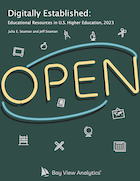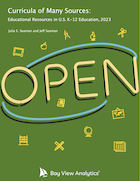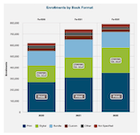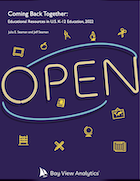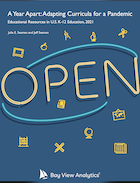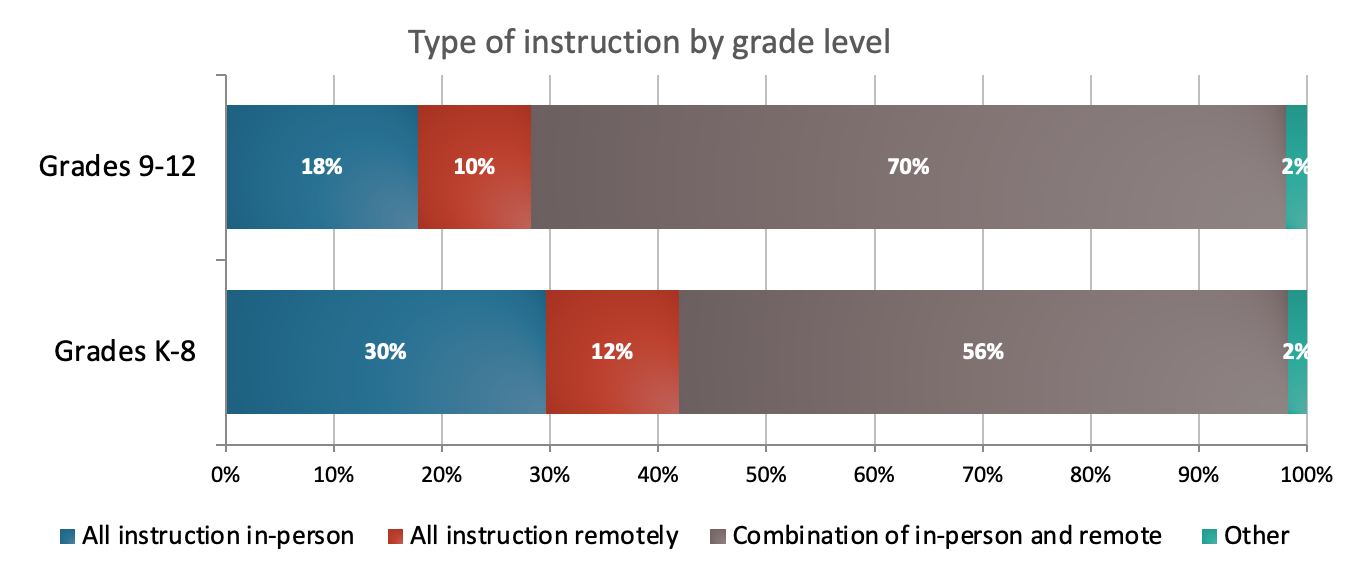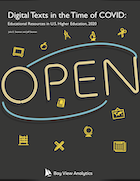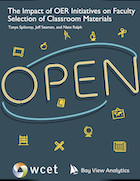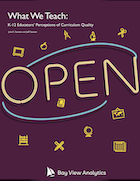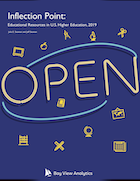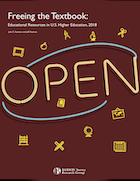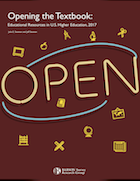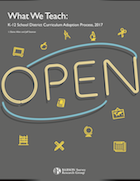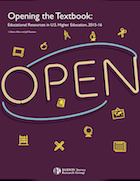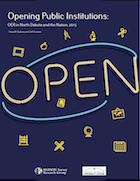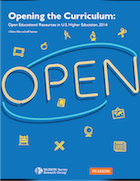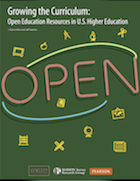Open Educational Resources
New Open Educational Resources reports released:
Digitally Established: Educational Resources in U.S. Higher Education, 2023
Download report: Digitally EstablishedNearly two thirds (64%) of U.S. higher education faculty are aware of open educational resources (OER) and nearly one third (29%) require an OER in their course, according to an annual survey of faculty and administrators. Both awareness and use of OER—which are openly licensed and thus free to use, edit, and share—jumped by seven percentage points compared to the 2021-22 school year, reaching their highest levels seen in the 12 years the survey has been administered.
Other key findings include:
• Faculty are most commonly using digital tools, like digital textbooks and homework software, to replace print tools like physical textbooks and homework handouts. But a small number of faculty are also utilizing new tools that have no physical counterpart, such as digital collaboration tools and student progress monitors.
• Faculty are generally satisfied with the overall quality of their curricula, as 50% gave their curricula a grade of either an A or B.
• 62% of faculty agree that the cost of course materials is a serious problem for their students.
• Although reported use of inclusive access programs—also known as automatic purchase programs—remains steady, there appears to be confusion around them, as 51% of faculty said they were not aware of these programs, compared to 44% who said they were unaware in 2021-22.
Curricula of Many Sources: Educational Resources in U.S. K-12, 2023
Download report: Curricula of Many Sources: Educational Resources in U.S. K-12, 2023More than three quarters (77%) of K-12 teachers create their own classroom materials to supplement or replace a textbook, and among those who do use a textbook, the same percentage (77%) offer it to their students in digital format, according to the results of an annual survey of K-12 educators and administrators. This gravitation toward self-created and digital materials is complemented by an increasing awareness of open educational resources (OER), which are free to use, edit and share. More than one in four (28%) teachers are now aware of OER and Creative Commons licensing—an uptick of six percentage points compared to the 2021-22 school year.
Other key findings include:
• Textbooks remain a fixture in classroom instruction, as 72% of teachers say they require a textbook in their classrooms.
• Over half of teachers agree that “they prefer print materials over digital for teaching” (57%), and that “students learn better from print materials than they do from digital” (59%). Half of teachers agree that “students prefer print over digital” (50%).
• Many teachers use digital tools in their classrooms on a daily basis. The most commonly used student-facing tools are laptops and tablets, and the most commonly used teacher-facing tools are digital grading and attendance tools.
• While slightly more than half of teachers (51%) give their curriculum a grade of an A or B, only a third of teachers (33%) give their professional development similarly high marks.
Bay View Analytics OER Research in the News
- Recent survey shows students’ concern about affording course materials Daily Collegian
- Students may avoid paying for textbooks at expense of academic success Penn State University
- Biden administration wants to crack down on inclusive access Nation World News
- Paywalled: Pitt students launch textbook affordability campaign Post Gazette
- Publishers resist changes to textbook access scheme Times Higher Education
- A third of Pa. college students sometimes go without textbooks because of cost, survey shows The Philadelphia Inquirer
- Survey: Course Materials’ Costs Impact Student Success Inside Higher Ed
- Paywalled: Cost of textbooks, course materials impacting Pa. college students Post Gazette
- Cost of textbooks, course materials impacting Pa. college students WITF
- 3 Questions for Ed Tech and Publishing Expert David Harris Inside Higher Ed
- What Works Better for Retention — Printed or Digital Texts? Government Technology
- It’s Time for Open Educational Resources Inside Higher Ed
- No one wants to pay $200 for a textbook Ed Scoop
- Faculty Awareness of OER Has Increased for 5 Years Straight, Yet Adoption Is Flat Campus Technology
- Awareness of Open Educational Resources Grows, but Adoption Doesn't Inside Higher Ed
- How Much of the K-12 Market Is Using Open Educational Resources? EdWeek Market Brief
- A Looming Challenge for OER? Inside Higher Ed
Recent Presentations
Online Learning Consortium Innovate 24
Does Location Matter for OER? Regional and institutional differences in higher education OER awareness and adoptionDate: April 13, 2024
Awareness of Open Educational Resources (OER) continues to rise, but levels of awareness vary by type of institution, and tend to be higher in the Western United States. This presentation will review these differences, and discuss potential causes. Over the last decade, OER awareness has increased year-over-year: from 27% in 2014-15 to 64% in 2022-23. This growth in awareness has been matched by similar though lower rates in reported use of OER in the classroom – from 5% in 2015-16 to 29% in 2022-23. However, this growth has not been uniform across the country or between institutions.
Download presentation slides (PDF)
Online Learning Consortium Innovate 24
UNDERSTANDING THE "WHAT" AND "WHY" OF K-12 INSTRUCTIONAL MATERIALS TO SUPPORT STUDENT SUCCESSDate: April 13, 2024
This research examines the spectrum of curricula materials employed in K-12 classrooms, differentiating between resources utilized by instructors and those intended for students. The presentation will focus on results from a national survey of K-12 teachers, investigating the differences between grade level and classroom subject as well as adoption and preferences for digital vs. print materials.
Overall, for student focused materials, student tablets or laptops and free online videos emerged as the most regularly used items. These are often utilized alongside self- or school-created quizzes/tests, additional reading, and homework assignments, available in both print and digital formats. While numerous materials see monthly use, daily materials are much less common.
Download presentation slides (PDF)
THECB OE Week
Session Title: A Pivotal Moment for OER: Using Research to Inform Strategic DirectionPresentation Time:: March 5, 2024, 3:00 - 4:00 PM CST
This session will allow participants to learn about THECB-commissioned statewide OER research that provides the foundation for strategic resource development, program, and service delivery. Our partners from Bay View Analytics and ISKME will join us to provide insights on open educaton based on research at the national and state levels, including a look at the results of the 3rd statewide OER Landscape Survey. Participants will have the opportunity to engage in valuable conversations on the impact of open education.
Download presentation slides (PDF)
USDLA 2023 National Conference
Session Title: Tracking OER Awareness and Adoption in US K-12 and Higher Education — Results from our 2022-23 National SurveyPresentation Time: July 19, 2023, 2:30 - 3:15 PM ET
This presentation reports the latest results from our national surveys tracking the awareness of open educational resources (OER) in US K-12 and higher education classrooms. Since 2009, Bay View Analytics has been tracking the growing awareness and adoption of OER through annual surveys of teachers, faculty, and administrators. The presentation show how OER trends vary by grade level, course discipline, and school demographics.
Download presentation slides
OLC Innovate 2023 - Featured Presentation
Session Title: Behind The Curtain For The Curricula Adoption Processes In OER And Non-OER ClassroomsPresentation Time: April 21, 2023, 11:45 AM to 12:30 PM CT
How and why are specific courseware materials chosen to be used? The curricula adoption process varies across institutions and departments. This presentation uses large-scale national survey data to look at the curricula adoption process and examine differences for OER vs. non-OER classrooms, by course level, and institution type.
Download presentation slides
OLC Innovate 2023
Session Title: Post-Pandemic Trends In U.S. Higher Education Digital And OER Textbook AdoptionsPresentation Time: Thursday, April 20, 2023, 9:30 AM to 10:15 AM CT
The use of digital materials in higher education classrooms is on the rise. Join us for a closer look at this transition from physical, print materials to a digital-first future over the last decade. We’ll discuss how we got here, and what this might mean for the future of education.
Download presentation slides
Recent Reports
Research Brief:Digital and OER Textbook Adoption
The global COVID-19 pandemic changed how faculty teach, and resulted in a large rise in digital curricula use. We partnered with the Brian Murphy Group to investigate how the digital adoption trend varied across different course disciplines. The study examines selected large-enrollment introductory-level courses for the Fall 2020, Fall 2021, and Fall 2022 terms. The results show that print textbooks remain a dominant form factor. But the growing demand for digital textbooks speaks to where demand may be heading.
Research Brief:
Faculty Satisfaction with Course Materials varies by Publisher
As part of our research into faculty satisfaction with curricula, we took a look at how satisfaction varies by publisher type, comparing major commercial publishers, smaller commercial publishers, and OER, and measured how OER fares across several factors. The study examines multiple aspects: overall, accuracy, scope of content, included instructor materials, and cost to student.
Turning Point for Digital Curricula: Educational Resources in U.S. Higher Education, 2022

Report Infographic: Turning Point for Digital Curricula
Turning Point for Digital Curricula: Educational Resources in U.S. Higher Education, 2022 found that while almost all higher education faculty have returned to their physical classrooms this school year, their reversion to print textbooks and other instructional materials they preferred before the pandemic hasn’t been nearly as swift
Key findings from the report include:
- While students are returning to the classroom, there has not been a return to pre-pandemic levels
- Faculty and administrators have expressed a growing acceptance, and even preference for online or blended learning environments, as well as digital courseware
- 86% of administrators and 64% of faculty agree that the cost of course materials is a serious problem
- Acceptance of digital course materials has grown, along with awareness and usage of Open Educational Resources (OER)
- A measure of OER awareness as well as licensing options, has grown to 57%(up 7%) this year.
Coming Back Together: Educational Resources in U.S. K-12 Education, 2022
Report Infographic: Coming Back Together Infographic
While almost all teachers have returned to their classrooms this school year, the newest Bay View Analytics report Coming Back Together: Educational Resources in U.S. K-12 Education, 2022 shows that their reversion to textbooks and other physical instructional materials they preferred before the pandemic hasn’t been nearly as swift.
More than nine in 10 teachers reported having returned to in-person instruction. But only 30 percent of teachers report their instructional materials are entirely or predominantly physical, down significantly from 2018-19 prior to the pandemic when 68 percent said physical materials were the norm.
The continued use of digital materials comes despite most teachers (61 percent) saying they prefer to use physical materials and nearly the same number (59 percent) expressing a belief that students learn better with physical materials. However, most teachers (55 percent) also believe that their students prefer digital materials.
A Year Apart: Adapting Curricula for a Pandemic, Educational Resources in U.S. K-12 Education, 2021
Report Infographic: A Year Apart: Adapting Curricula for a Pandemic Infographic
A Year Apart: Adapting Curricula for a Pandemic is one of a series of annual surveys of K-12 teachers and administrators in the U.S. This year's report found that the sudden shift to remote instruction caused by the COVID-19 pandemic spurred significant and potentially lasting changes to the landscape of instructional materials. The majority of teachers were forced to make moderate or considerable curricula changes as they made the switch to remote instruction. Additionally, the results suggest that these changes, and increased adoption of digital tools in the classroom, are here to stay.
Key findings include:
- 74% of teachers reported that they were teaching remotely or using some combination of remote and in-person instruction; 58% of respondents reported having no prior online teaching experience.
- The new curriculum materials were acquired from commercial sources (33%) or were primarily developed by teachers (25%). Open-source curricula were used by 37% of districts for supplementary materials, and 97% of teachers used some form of video instruction.
- Teachers with prior online experience had greater awareness of open educational resources (OER) and licensing types; they were 14% more aware of Creative Commons and public domain, and 9% more aware or likely to have heard of OER.
The study was conducted by Bay View Analytics in partnership with Online Learning Consortium and funded by a grant from The William and Flora Hewlett Foundation. It was based on representative sample of 2,168 K-12 teachers and administrators in U.S. school districts in March 2021.
Digital Texts in the Time of COVID: Educational Resources in U.S. Higher Education, 2020
The Fall 2020 academic term saw a dramatic shift in the proportion of higher education faculty teaching online, driving a transition of existing courses and educational materials into digital formats, according to a survey of faculty conducted by Bay View Analytics. Survey results also show that while the level of awareness of open educational resources (OER) grew for the fifth straight year, OER adoption rates remained stable.
The study, Digital Texts in the Time of COVID: Educational Resources in U.S. Higher Education, 2020, was conducted by Bay View Analytics and supported by a grant from The William and Flora Hewlett Foundation. The results reflect responses from over 3,200 faculty and department chairpersons. The report shows improvements in faculty satisfaction with OER textbooks and an increased reliance on digital materials to meet the demands of online instruction.
- Faculty who have adopted OER rate their quality slightly superior to that of commercial alternatives.
- The level of adoption of OER as required course material did not increase, marking the first time that growth in awareness was not coupled with growth in adoption. The adoption of OER as supplemental materials continued its year-over-year growth, however.
- A majority of faculty modified their courses for the fall term, with 79% reporting these changes were driven by pandemic-related issues.
- As was true last year, faculty who are aware of institutional or system-level OER initiatives were three to four times as likely to adopt OER as those who were not aware.
- OER plays a more prominent role at minority-serving institutions than at other types of higher education institutions. Faculty at these institutions are more likely to have adopted OER materials, both for required and supplemental materials, than faculty at other types of institutions.
The Impact of OER Initiatives on Faculty Selection of Classroom Materials
The adoption of open educational resources (OER) is on the rise, driven in part by increasing awareness of OER. But while faculty and institutions have shown increasing awareness and acceptance of OER, many remain unfamiliar with what they are, or how to utilize them.
- Faculty who are aware of one or more OER initiatives are much more likely to be adopters of OER. This holds true for both faculty teaching introductory-level courses, and the general population of faculty.
- When implemented at the institutional level, OER initiatives result in a measurable rise in the number of faculty who are aware of OER.
- Faculty who are aware of OER are much more likely to adopt OER as required course materials; those who have yet to adopt OER are much more likely to do so in the future.
- The impact of awareness of OER initiatives on adoption remains consistent across types of institutions (two- and four-year), the level of course being taught, and across regional compacts in the U.S.
What We Teach: K-12 Educators’ Perceptions of Curriculum Quality
A survey of 2,137 teachers, school-level administrators, and district administrator shows that they view the quality of curricula based on open educational resources (OER) as equal to offerings from commercial publishers. The research, conducted by Bay View Analytics, also shows a strong relationship between educators’ perceptions of the effectiveness of professional development on a curriculum and the quality of that curriculum.
- Three commercial publishers (Pearson, McGraw-Hill, and Houghton Mifflin) command the largest market shares for providing curricula materials, but together account for less than half of the adoptions.
- The number of districts designing their own curriculum is almost as large as the amount selecting from one of the top three publishers.
- OER adoptions are concentrated in Mathematics, where 14% of adoption decisions were OER, compared to 4% for English Language Arts, 2% for Science, and 1% for History and Social Studies.
- School districts are well-versed in including student technology use as part of the learning process.
Previous Open Educational Resources reports
Inflection Point: Educational Resources in U.S. Higher Education, 2019
The model of course material distribution and selection is at an inflection point.
- There is a growing acceptance (even preference) by faculty for digital materials. More faculty now prefer digital over print, and they report that their students are likewise accepting of digital materials.
- Faculty, chairpersons, administrators, and even entire college systems are increasingly concerned about the cost of materials for their students. This is driven by historically rising prices, and the emergence of lower-cost alternatives, resulting in a growing awareness of cost as an issue at multiple levels within the institution.
- Faculty report that many of their students are going without the required text. This is reported as primarily a cost concern, but also because the students are not convinced that they need the materials.
- The introduction of new publishing and distribution models by commercial publishers, the most important being "inclusive access," has substantially altered the options available to faculty.
Freeing the Textbook: Open Education Resources in U.S. Higher Education, 2018
A 2017-2018 survey on teaching materials in U.S. higher education shows steady growth in awareness of open educational resources (OER). Responses from over 4,000 faculty and department chairpersons paint a picture of steady improvement, with almost 50% of faculty now reporting OER awareness.
The study also shows multiple factors are in place to support rapid future increases in awareness and use of OER:
- Faculty and department chairpersons believe that the high cost of course material has a negative impact on student access.
- The 5Rs that underpin OER (Retain, Reuse, Revise, Remix and Redistribute) are a perfect match to the extensive use of 'revise' and 'remix' that faculty are already practicing.
- Faculty members express considerable resentment towards commercial publishers over cost and unnecessarily frequent updates, among other issues.
- Faculty report a growing acceptance (or even preference) for digital materials.
- The 'open' aspect of OER resonates with faculty; they see it as an excellent match to academic principles.
These results could signal a turning point for OER, with potentially faster levels of growth to come. However, the study results also show that many of the factors that have prevented rapid growth remain. Overall awareness of OER is at about 46%, so while most faculty have real concerns about the cost of course materials and use textbooks in a manner that is best supported by OER, slightly more than half remain unaware of the OER alternative. Institutional level initiatives to educate faculty about OER are limited, and faculty have been left to find their own solutions to the high cost of materials.
Full Report PDF: Freeing the Textbook: Open Education Resources in U.S. Higher Education, 2018 (pdf)
Opening the Textbook: Open Education Resources in U.S. Higher Education, 2017
Responses from over 2,700 U.S. faculty paint both a "Good news" and a "Bad news" picture for the role of open educational resources (OER) in U.S. higher education. The levels of awareness of OER, the licensing tied to it, and overall adoption of OER materials, remains low. Only 10% of faculty reported that they were “Very aware” of open educational resources, with 20% saying that they were “Aware.” Faculty continue to report significant barriers to OER adoption. The most serious issues continue to be the effort needed to find and evaluate suitable material.
There is also considerable cause for optimism among those who support OER. The awareness and adoption levels may be low, but they also show steady year-to-year improvements. OER also addresses a key concern of many faculty: the cost of materials.
- Full Report PDF: Opening the Textbook: Open Education Resources in U.S. Higher Education, 2017 (pdf)
- Web version: HTML version of report body (fully formatted)
- Web version: HTML version of report body (minimal formatting for those who want to copy and reuse)
- Web version: HTML version of report tables (fully formatted)
- Web version: HTML version of report tables (minimal formatting for those who want to copy and reuse)
- Charts: Zip file of report charts as image files
- Charts: Excel file of tables and charts
- Plain text: Plain text version of report body
What We Teach: K-12 School District Curriculum Adoption Process, 2017
Over three-quarters of K-12 districts have made at least one full-course curricula adoption decision over the past three years, with the need to meet changing standards driving most of these decisions, according to the results of a new survey from the Babson Survey Research Group.
The project, funded by a grant from The William and Flora Hewlett Foundation, surveyed a national sample of over 500 decision makers in K-12 school districts to examine the process by which they made curriculum adoption decisions and the extent to which open educational resources (OER), freely available materials that can be copied, edited and shared, factor into those decisions. Key findings from the report include:
- The overwhelming reason districts cite as the reason to engage in an adoption decision is a need to select new material to meet changing standards.
- Teachers have decision-making power in the adoption process for 94% of districts, followed by district-level administrators (75%), and principals (73%).
- Full Report PDF: What We Teach: K-12 School District Curriculum Adoption Process, 2017 (pdf)
- Web version: HTML version of report body (fully formatted)
- Web version: HTML version of report body (minimal formatting for those who want to copy and reuse)
- Web version: HTML version of report tables (fully formatted)
- Web version: HTML version of report tables (minimal formatting for those who want to copy and reuse)
- Charts: Zip file of report charts as image files
- Charts: Excel file of tables and charts
- Plain text: Plain text version of report body
Opening the Textbook: Open Education Resources in U.S. Higher Education, 2015-16
Survey results, using responses of over 3,000 faculty, show that OER status is not a driving force in the selection of educational materials – with the most cited barrier being the effort required to find and evaluate such materials. While use of open resources is low overall, it is somewhat higher among large enrollment introductory-level courses.
Faculty awareness of open educational resources has increased, with 25% of faculty reporting that they were “Aware” or “Very Aware” of OER, up from 20% last year.
However, only 5.3% of courses are using open textbooks (which includes public domain and Creative Commons licensed materials). Large enrollment introductory undergraduate courses have adopted openly licensed OpenStax College textbooks at twice the rate (10%) as openly licensed textbooks among all courses.
- Full Report PDF: Opening the Textbook: Open Education Resources in U.S. Higher Education, 2015-16 (pdf)
- Web version: HTML version of report body (fully formatted)
- Web version: HTML version of report body (minimal formatting for those who want to copy and reuse)
- Web version: HTML version of report tables (fully formatted)
- Web version: HTML version of report tables (minimal formatting for those who want to copy and reuse)
- Charts: Zip file of report charts as image files
- Charts: Excel file of tables and charts
- Plain text: Plain text version of report body
Opening Public Institutions: OER in North Dakota and the Nation, 2015
North Dakota University System faculty are just beginning to understand the potential for open educational resources (OER). The Open Educational Resources Initiative in North Dakota is the result of a 2013 Legislative interest urging the North Dakota University System (NDUS) to reduce the cost of textbooks estimated to be $1,100 per year per student. The idea is now becoming a reality with the launch of a statewide initiative.
This study is a statewide replication of the Babson Survey Research Group's national investigation of OER adoption and will be used as a benchmark, against which future advances will be measured. The North Dakota results, based on responses from faculty at the 11 NDUS campuses, are compared with those from the national sample of faculty members.
Full Report PDF: Opening Public Institutions: OER in North Dakota and the Nation, 2015 (pdf)
Opening the Curriculum: Open Education Resources in U.S. Higher Education, 2014
This report, funded by a grant from The William and Flora Hewlett Foundation with additional support from Pearson, examines the attitudes, opinions, and use of open educational resources (OER) among teaching faculty in U.S. higher education.
- PDF: Opening the Curriculum: Open Education Resources in U.S. Higher Education, 2014 (pdf)
- e-Book for Kindle (.mobi format): Opening the Curriculum (.mobi)
- e-Book for iPad or Nook (.epub format): Opening the Curriculum (.epub)
- Infographic: Opening the Curriculum Infographic
Growing the Curriculum: Open Education Resources in U.S. Higher Education, 2012
This 2012 report, funded by a grant from The William and Flora Hewlett Foundation with additional support from Pearson, examines the role of open educational resources in higher education. As part of ongoing online learning reports conducted by the Babson Survey Research Group, we have asked institutional academic leaders questions on their knowledge, use and opinion of OER. In addition, the Babson Survey Research Group conducted surveys asking faculty in higher education and academic technology administrators their opinions of these resources. Our survey of faculty on their use of social media also asked for faculty opinions on OER. This report uses data from all of these sources.
- Full Report PDF: Growing the Curriculum: Open Education Resources in U.S. Higher Education (pdf)
- Infographic: Growing the Curriculum Infographic
Recent Publications
Digital Learning Pulse Surveys
- Infographic: 2023-2024 Digital Learning Pulse Survey
- The Digital Transformation of the Community College
- Planning for a Smaller Future: Dealing with Declining Enrollments
Course Material Affordability
- Pennsylvania Course Materials Survey 2023
- Pennsylvania Course Materials Presentation
- Course Material Webinar Slides
Open Educational Resources
- Digitally Established: Educational Resources in U.S. Higher Education, 2023
- Curricula of Many Sources: Educational Resources in U.S. K-12, 2023
- Research Brief: Digital and OER Textbook Adoption
- Research Brief: Faculty Satisfaction with Course Materials varies by Publisher
STEM
- Teaching Online: STEM Education in the Time of COVID
- What Makes a STEM Student
- Perceptions of the Future of STEM Education
Distance Education
- Digital Faculty: Faculty Social Media Use and Communications
- Infographic: Digital Faculty
- Grade Increase: Tracking Distance Education in the United States
Follow us on
Privacy
All survey respondents are provided complete anonymity. No personally identifiable information is released. Full privacy policy.
